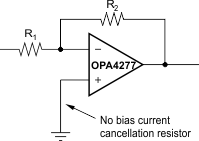SBOS714 November 2014 OPA4277-EP
PRODUCTION DATA.
- 1 Features
- 2 Applications
- 3 Description
- 4 Revision History
- 5 Pin Configuration and Functions
- 6 Specifications
- 7 Detailed Description
- 8 Application and Implementation
- 9 Power Supply Recommendations
- 10Layout
- 11Device and Documentation Support
- 12Mechanical, Packaging, and Orderable Information
Package Options
Mechanical Data (Package|Pins)
- D|14
Thermal pad, mechanical data (Package|Pins)
- D|14
Orderable Information
1 Features
- Ultra-Low Offset Voltage: 10 μV
- Ultra-Low Drift: ±0.1 μV/°C
- High Open-Loop Gain: 134 dB
- High Common-Mode Rejection: 140 dB
- High-Power Supply Rejection: 130 dB
- Low Bias Current: 1-nA Max
- Wide Supply Range: ±2 to ±18 V
- Low Quiescent Current: 800 μA/Amplifier
- Supports Defense, Aerospace, and Medical Applications
- Controlled Baseline
- One Assembly and Test Site
- One Fabrication Site
- Available in Military (–55°C to 125°C) Temperature Range
- Extended Product Life Cycle
- Extended Product-Change Notification
- Product Traceability
2 Applications
- Transducer Amplifier
- Bridge Amplifier
- Temperature Measurements
- Strain Gage Amplifier
- Precision Integrator
- Battery Powered Instruments
- Test Equipment
3 Description
The OPA4277-EP precision operational amplifier replaces the industry standard OP-177. It offers improved noise, wider output voltage swing, and is twice as fast with half the quiescent current. Features include ultra-low offset voltage and drift, low bias current, high common-mode rejection, and high power supply rejection.
The OPA4277-EP operates from ±2- to ±18-V supplies with excellent performance. Unlike most operational amplifiers which are specified at only one supply voltage, the OPA4277-EP precision operational amplifier is specified for real-world applications; a single limit applies over the ±5- to ±15-V supply range. High performance is maintained as the amplifier swings to the specified limits. Because the initial offset voltage (±20-μV max) is so low, user adjustment is usually not required.
The OPA4277-EP is easy to use and free from phase inversion and overload problems found in some operational amplifiers. It is stable in unity gain and provides excellent dynamic behavior over a wide range of load conditions. The OPA4277-EP features completely independent circuitry for lowest crosstalk and freedom from interaction, even when overdriven or overloaded.
Device Information(1)
| PART NUMBER | PACKAGE | BODY SIZE (NOM) |
|---|---|---|
| OPA4277MDTEP | SOIC (14) | 3.91 mm × 8.65 mm |
- For all available packages, see the orderable addendum at the end of the data sheet.
Simplified Schematic
